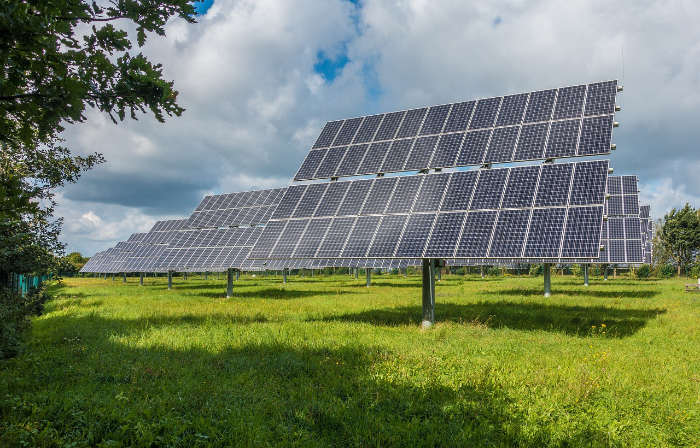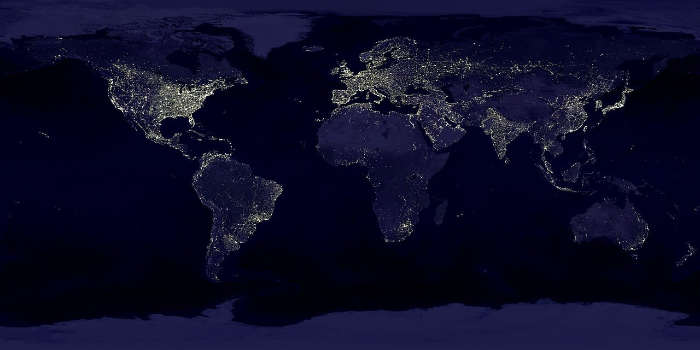Solar Power by Country 2025

0
100K
200K
300K
400K
500K
600K
5 Countries with the Highest Solar Power Capacity
- Values displayed in megawatts (MW), a unit of measurement equivalent to 1 million watts (or 1,000 kilowatts).
Solar power is clean, green, inexpensive, and renewable energy that is produced when sunlight strikes human-made solar cells and is subsequently converted into electricity. Solar power is effectively infinite in supply and can be generated at any point at which sunlight reaches the ground in every country on Earth. Solar energy also prevents the negative impacts of fossil fuels, such as greenhouse gas emissions from coal consumption.
The use of solar power is increasing worldwide. By the end of 2023, photovoltaic solar arrays provided an estimated 6.5% to 7% of the world’s electricity, marking a continued rise in its contribution to global energy generation. According to the 2022 edition of the annual report published by SolarPower Europe, “global solar capacity doubled in 3 years from 2018, bringing the world’s solar fleet to one Terawatt capacity in April 2022.” In 2024, SolarPower Europe declared that solar installed capacity had doubled since 2022 to two Terawatt, showing an astounding rate of growth.
Solar has massive potential to transform life on our planet. According to a 2024 report by the World Bank, off-grid solar has the potential to bring electricity to nearly 400 million people worldwide for the first time by 2030. Nearly every country in the world has the right combination of geographic conditions, weather, and sunlight to generate all the electricity it needs—and more—using solar power facilities placed within its own borders.
Top 10 Countries That Produce the Most Solar Power (Megawatts, 2023)
Solar Power in the United States
With 139,205 MW of solar power online and more on the way, the U.S. currently has enough solar power capacity to power more than 21 million households. A report from the National Renewable Energy Laboratory found that solar power accounted for 54% of new U.S. electricity generation capacity in 2023, with 22 states generating more than 5% of their electricity from solar, led by California at 28.2%.
Types of Solar Energy Production
Solar energy is typically harnessed using either photovoltaic (PV) or concentrated solar power (CSP) systems. Photovoltaic systems are by far the more common and versatile of the two. Photovoltaic systems generate electricity directly from sunlight via solar cells: when solar radiation (sunlight) strikes a photovoltaic solar cell, photons transfer energy to electrons in the semiconductor material (usually silicon), exciting them and enabling the flow of electrical current, which can then be used immediately, stored in a battery, or fed into the electrical grid.
Solar cells absorb a range of wavelengths of light. Other wavelengths are either reflected, lack sufficient energy to be efficiently converted (infrared), or produce excess heat instead of electricity (ultraviolet). However, solar cell technology continues to improve, increasing the efficiency of the conversion process.
The second-most-common method of harnessing solar energy is the concentrated solar power (CSP) system. CSP plants produce electricity indirectly using solar thermal collectors, which concentrate solar energy to heat a fluid generating steam that drives a turbine to produce electricity. Globally, current CSP installations generate only a fraction as much energy (6,387 MW) as photovoltaic systems (843,086 MW).
Solar Power by Country
According to the International Energy Agency Snapshot 2024, China alone accounted for over 60% of new global photovoltaic capacity in 2023, with the top 10 countries collectively representing a significant majority of the market. As of 2023, China has the largest solar energy capacity in the world at 609,921 megawatts (MW), contributing approximately 3% to the country’s total electricity production. It is followed by the United States at 139,205 MW and Japan at 89,077 MW.
However, total capacity is only one way to view solar production. Another method is to examine solar penetration—that is, the percentage of each country’s total energy consumption that comes from its solar installations.
A Brief History of Solar Power Technology
The origin of modern solar cells can be traced back to 1954, when Bell Labs introduced the first PV device capable of producing a usable amount of electricity. The energy crisis of the 1970s resulted in a groundswell of interest in using solar energy to produce electricity for homes and businesses. At the time, the high manufacturing costs of solar cells (a relatively new technology) made large-scale applications impractical. Over time, the cost of photovoltaic cells has dropped dramatically, including a decrease of more than 64% for residential systems, 69% for commercial systems, and 82% for utility-scale systems over the past decade, making solar affordable for not only utilities and corporate offices, but for private homes as well.
Sources
- Renewable Energy Statistics 2024 - IRENA International Renewable Energy Agency
- Renewable Energy Statistics 2023 (pages 21-24) - IRENA International Renewable Energy Agency
- Renewable Energy Statistics 2022 - IRENA International Renewable Energy Agency
- Renewables 2021 - International Energy Agency
- Solar Photovoltaic Power Potential by Country - World Bank
- Solar Power by Country - Wiki
- Snapshot 2021 - International Energy Agency
- Snapshot 2022 - International Energy Agency
- Snapshot 2023 - International Energy Agency
























